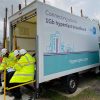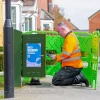Parliamentary Debate Hauls Brsk’s UK Broadband Poles Over the Coals UPDATE

Broadband network builder and UK ISP Brsk, which is in the process of being merged into Netomnia (here), yesterday found itself being the perhaps unwanted centre of attention (again) during a debate in parliament that focused on the problems being caused by the deployment of “telegraph poles” in Birmingham.
Just to recap. Brsk has so far deployed their 10Gbps capable Fibre-to-the-Premises (FTTP) broadband network to cover “over” 700,000 UK homes, which tends to involve a mix of both underground (i.e. new trenching and harnessing Openreach’s existing cable ducts, where available) and overhead work (i.e. running fibre cables via both new and existing telegraph poles).
The deployment of wood poles to run overhead fibre is a common practice (over 4 million have already been built). This is because poles are quick and cost-effective to build (several times cheaper than trenching), can be deployed in areas where there may be no space or access agreement to safely put new underground cables, are less disruptive (avoiding the noise, access restrictions and damage to pavements of street works) and can be built under Permitted Development (PD) rights with only minimal prior notice.
Advertisement
On the flip side, such deployments have attracted a fair few complaints over the past few years. Suffice to say that a lot of people find them ugly, particularly when deployed in areas that haven’t had them before, which has in some parts of the country triggered strong anti-pole protests.
Brsk is no stranger to such complaints (here, here, here and here) and their deployment around Birmingham is already the subject of an Ofcom investigation (here), with the regulator looking to see whether the operator failed to provide the expected 28 days’ written notice to a local planning authority before installing some of their poles. This reflects the “voluntary” guidelines under the Revised Cabinet and Pole Siting Code of Practice Nov 2016.
The Parliamentary Debate
Yesterday’s debate in parliament – ‘Telegraph Poles: Birmingham‘, which was raised by the Labour MP for Birmingham Edgbaston, Preet Kaur Gill, similarly echoed many of the complaints we’ve seen before and named Brsk as one of the “cowboys” of the industry.
Otherwise, the debate generally followed the usual structure, with various MPs acknowledging the need for better broadband, while also repeating many of the now familiar talking points around the need for better infrastructure sharing between operators (not only with Openreach) and rules to make it easier to challenge the deployment of poles.
Advertisement
Preet Kaur Gill MP said:
“While the majority of providers are trying to do right by local people by making efforts to consult and not put up poles, some providers in my constituency such as Brsk have occasionally behaved like cowboys by not using existing infrastructure, failing to consult residents with the adequate 28 days’ notice, failing to observe the Disability Discrimination Act 1995 requirements to ensure that pathways are clear and accessible until they are told to do so, failing to secure the right council permits for works, and putting up poles everywhere as the only means to address coverage.
Given that Brsk’s business is communications, it is ironic how poor it has been at communicating with its stakeholders. The crux of the issue is that such companies are not exploring alternatives to poles or using existing infrastructure when they can. I will give some of many examples.
Freedom of information requests to our local council revealed that Brsk did not need to put up poles on Clarendon Road in my constituency, because it could have utilised existing ducts—but it did so anyway, ignoring that fact. Vernon Road is another example; BT [Openreach] installed full-fibre to St Paul’s school for girls at that location without any requirement for poles, yet a constituent came to my surgery on Friday to tell me that another pole had gone up, with a notice on the council’s planning portal appearing only after the pole had been erected. That is even after the Minister’s meeting with Brsk.
I have met Brsk and exchanged exhaustive correspondence on these issues. What has struck me in my dealings with the firm is the lack of policy or strategy for work in my constituency. Poles are supposed to be a last resort, but even where they are not needed, like on Vernon Road, several go up anyway. There are now four on that road. Frequently, when issues are raised, they are not listened to. I asked Brsk for a map of where it is planning to roll out poles in my constituency, and it could not give me one. There is either a plan that it will not share or there really is no strategic focus on where the infrastructure is needed.”
In fairness, the debate also shows that Brsk, on quite a few occasions, has agreed to remove poles when they cause enough complaints. This should perhaps be considered more of a positive, as other operators have not always been so flexible. On the other hand, Preet points out that “it should not take a well-organised community campaign and an active local MP to get a provider to meet its statutory duties“.
As usual, there were also some calls for greater infrastructure sharing, which is an extremely complicated area. Some MPs and their constituents often suggest that this is an easy problem to resolve and have a tendency to over-simplify the challenges. In reality, most operators already do everything possible to share existing poles and ducts, since that’s a lot more cost-efficient than building new stuff (e.g. Openreach’s network is widely re-used by rivals via a regulated solution as they have a dominant market position, with KCOM also moving slowly in this sort of direction)
However, it isn’t always possible to share infrastructure in every location, due to a mix of local restrictions and limitations (commercial or practical) imposed by existing operators. Sometimes no viable underground alternatives exist to poles, such as if past cables have been direct buried without ducts or the pavement already has too much underground infrastructure (i.e. digging more would be unsafe).
Meanwhile, a smaller network operator might build a new trench and ducting but keep it closed to rivals in order to protect the value of what is still a very high-risk investment (i.e. not allowing other altnets a free ride). If they weren’t able to do that, then they might have just built poles or not deployed at all. The latter would be to the disadvantage of people who wanted access to more competitive FTTP networks and don’t mind poles.
Advertisement
The existing Access to Infrastructure (ATI) Regulations 2016, which applies to all operators, does include provisions on the exchange of information about existing infrastructure, and the right to access that infrastructure on fair and reasonable commercial terms etc. But this doesn’t matter much if a commercially viable deal cannot be reached or operators only want to work with Openreach’s regulated solution (not each other). But INCA has setup a new Infrastructure Sharing Group (ISG) that will attempt to tackle some of the obstacles that still exist (here).
The Government’s Position
The previous government, driven by its targets for expanding gigabit-capable broadband infrastructure “nationwide” (c.99% coverage) by 2030 under their £5bn Project Gigabit programme, facilitated today’s market by cutting red tape to help make such work as easy as possible. This, along with other changes and investment programmes, has helped to attract tens of billions of pounds in private investment and spurred a massive commercial deployment that recently saw UK gigabit coverage pass 85% – something the new government wants to continue (Ofcom predicts it will reach around 97-98% by May 2027 – here).
However, the new Labour-led government, much like the old Conservative-led one, has also called on broadband operators to “end the deployment of unnecessary telegraph poles” (here), to “share existing infrastructure when installing broadband cables as the default approach” and pledged to “revise” the existing Code of Practice (as linked earlier).
The Minister for Telecoms, Sir Chris Bryant, broadly demonstrated a good understanding of both sides of the argument with his various responses to the latest concerns. Bryant also reiterated that an updated version of the Code of Practice “might” be due sometime in the New Year, although exactly when it still not set in stone.
Sir Chris Bryant, UK Minister for Telecoms, said yesterday:
“The Government will intervene in the areas where that will not happen commercially, but I say to the hon. Member for Wyre Forest and my hon. Friend the Member for Birmingham Edgbaston that we have to be a bit careful about saying, “It’s disgraceful that these people are making money”, because if they did not make money, they would not be rolling it out on a commercial basis and then we might have to intervene a great deal more in the market. But there is a countervailing argument: if operators behave in a way that lacks compassion or sensitivity to the local situation, it is extremely unlikely that anybody in that local community is going to buy their products, so it could destroy their commercial agendas and business strategies if they are so high-handed in their approaches to local communities when it comes to the siting of poles and so on.
….
This Government have been very clear, and the previous Government were relatively clear, that we wanted this infrastructure to progress in a way that was sensitive to local communities. That meant that we had to have proper consultation and to be careful about the siting of poles. We wanted to encourage co-operation and collaboration between different players in the market, so that roads were not dug up two years in a row or three months after the last company dug it up, for example. All that was laid out in the original guidance in 2016. Incidentally, that guidance was provided not by the Government but by the industry. This is an important point: the industry is currently looking at revising that code. It is very close to a revised version. I do not think that that is quite ready yet, but I anticipate that it might come in the new year.
The simple point that I have made repeatedly to all the operators in this field is that if they want people to take up their service and buy their product, they have to take people with them. At our meeting with Brsk last week, Brsk made it clear that if all the members of a community, especially one cut off from everywhere else and not on the way to another place, said, “Look, we don’t want this,” it would work out that there was no point putting in poles, digging up the road or whatever, because there would not be any take-up of its services from that community in future. It would simply say, “All right, fine. We’re not going there.””
Despite Chris’s closing remark above, he did acknowledge that the “difficulty lies where one road leads—as is often the case—to another, and the people on the next bit of road still want the roll-out even if the people on the first bit do not” (i.e. if one street / community blocks the roll-out, then it can sometimes prevent the new network from reaching beyond that area – disadvantaging those who may want it).
“The commercial reality is that inserting a new duct—that is, digging up the road and putting everything underground —might be very attractive to everybody in the community, but it is nine or 10 times more expensive than putting things on poles. If we want commercial operators to roll things out, there are certain situations where there are going to be poles. I cannot hide that from anybody; it is a simple reality,” added Chris.
The government’s telecoms minister has previously suggested that Permitted Development (PD) or other rights for poles could be taken away from network operators that don’t play by the rules. But we’d hope this would, if ever enacted, be a targetted and temporary sanction, and not an industry-wide restriction, as the latter would be suicidal for related investment and coverage plans.
However, questions remain over what practical changes the new Code of Practice will actually deliver, since any overly burdensome changes risk increasing the costs of deployment for operators and thus potentially reducing their roll-out plans (i.e. causing a negative impact on the government’s targets). But we do anticipate that it will most likely result in a need for greater pre-build consultation with communities, as well as some improvements to the complaints process.
As for Brsk, Chris Bryant pledged to “hold their feet to the fire on all the commitments that [they’ve] made in private meetings with me, in the meetings with MPs that we held last week, and in writing“. The minister added that, before Brsk starts rolling out in a particular area, it needs to “explore far more thoroughly” what ducting might be available, which “might be through Openreach or Virgin” (Virgin’s network is currently closed, although it will open to wholesale later in 2025). It must also “consult properly in a local area where people lobby and argue that the siting of a pole is particularly inappropriate” and it has promised to “look at moving” poles in so far as it possibly can.
UPDATE 12th Dec 2024 @ 5:22pm
Brsk has kindly provided a long comment on the aforementioned issues.
A spokesperson for Brsk told ISPreview:
As highlighted in recent discussions with local and national bodies, our network is built within and on the existing telecommunications infrastructure as per Code Powers issued by OFCOM, using the Openreach PIA (Physical Infrastructure Access) Product. However, sometimes the existing infrastructure is insufficient for us to use due to issues such as DiG (Direct in Ground, buried cable), as is the case with the areas highlighted by Preet Kaur Gill MP.
We thoroughly survey all locations on our rollout plans to determine the availability of PIA infrastructure prior to any work taking place, so as to identify the most appropriate approach. In the areas mentioned, which have been in build and undergoing resident engagement since 2023, there are no viable underground feeds along these roads, and no underground ducts for us to make use of.
We endeavour to use existing infrastructure as far as possible. Across our entire Birmingham rollout we have utilised 7,500 BT Openreach poles and 1,400km of PIA duct to date, which has enabled us to provide service to over 70,000 residences and businesses in the area. As our footprint expands in this area we expect to see this significantly increase.
We will continue to have open and ongoing discussions with communities and their representatives as our builds continue. As stated by the Minister and Preet Kaur Gill MP, we recently attended a roundtable meeting hosted by the Minister with concerned MPs from a number of our build areas. We were disappointed that Preet Kaur Gill MP was unable to attend but we hope to engage with her as a matter of urgency.
Subsequent to the roundtable we have shared a fact sheet regarding brsk’s national build with the MPs who attended and will be sharing this with all MPs whose constituencies we build in moving forward.
Mark is a professional technology writer, IT consultant and computer engineer from Dorset (England), he also founded ISPreview in 1999 and enjoys analysing the latest telecoms and broadband developments. Find me on X (Twitter), Mastodon, Facebook, BlueSky, Threads.net and Linkedin.
« Tesco Mobile Adopt New UK Pricing Policy for Mid-Contract Hikes UPDATE























































Politicians are so tiresome. They are in charge! They made these rules, can’t complain when companies follow them.
“Well well well, if it isn’t the (perhaps unintended) consequences of my own actions”
Vernon Road looks at least partly DiG as does Clarendon Road. The DIA to the school isn’t really relevant, Excess Construction Costs are a thing and may have been some duct between footway boxes available.
Given mention of it the MP may have been referring to some Virgin Media duct also.
No special access needed here: go to Google Maps and look at Streetview. Note the size and frequency of footway boxes. That size and frequency indicate presence of directly buried cabling.
BT Group aren’t a public body so don’t respond to FoIs, unsure where those come in, but will absolutely respond to an MP with the appropriate information if they ask the right questions.
Nimbys will complain and then still order the service regardless. If your greatest worry in life is a wooden poll, you’re pretty comfortable
What are the poles used for?
If they are used in the same way OR poles use them then fair enough.
If they are used for a ‘WiFi on a pole’ then it needs banning.
YIMBY here for BRSK. VM was our only alternative so managed to convince BRSK to put a pole in our front garden which serves us and our neighbours. Looks a lot better than if they’ve have dug up the road and pavement to get to it.
Obviously would have been ideal if they could have used the VM ducting, so fingers crossed that works out
IMO this is another example of why the passive infrastructure (poles, ducts, etc.) should be owned by the government as opposed to for-profit companies. The government could then be obliged to maintain them, ensure available capacity for new providers, and produce access on FRAND terms.
30 years too late.
If the government can’t, deal with a few nimbys not wanting poles that the rest of the real world already have, then no way will they overcome these people when seeking to build 1.5 million houses in the next 5 years.
BRSK installed a load of poles around here in South Birmingham, my property has no real line of sight to any of them on my street, they make the estate seem overly congested as it was never designed with poles in mind. VM is underground and OR is DIG.
Of course with the recent storms guess who’s infrastructure got damaged and hasn’t been repaired as yet?
The only way I would consider switching to them if available is if they did it properly and trenched.